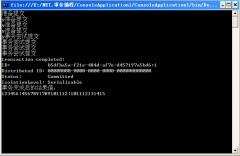C#中使用反射的性能分析
来源:网络整理 责任编辑:admin 发表时间:2013-07-01 07:05 点击:次
最近在研究一个可配置系统的框架,在代码中大量使用了反射的方法,虽然借鉴到其他的语言,如java中反射性能都比较差,但是想到c#既然是一种强类型的语言,对于AppDomain中的类的调用应该性能不会差很多。
今天在mvp站点上看到有人说反射的性能很差,要避免使用,就写了一个简单的例子测试了一下
测试类如下:
namespace ReflectionTest.Test
{
public class CTester
{
public CTester()
{
a = 10;
}
public void test1()
{
a = (a - 0.0001) * 1.0001;
}
private double a;
public double geta() { return a; }
}
}
首先我们对于对象的构造进行测试
测试代码如下
private void test1()
{
label1.Text = "";
label3.Text = "";
DateTime now = DateTime.Now;
for (int i = 0; i < 1000; i++)
{
for (int j = 0; j < 100; j++)
{
CTester aTest = new CTester();
}
}
TimeSpan spand = DateTime.Now - now;
label1.Text = "time past " + spand.ToString();
}
private void test2()
{
label2.Text = "";
label4.Text = "";
DateTime now = DateTime.Now;
for (int i = 0; i < 1000; i++)
{
for (int j = 0; j < 100; j++)
{
Type theTest = Type.GetType("ReflectionTest.Test.CTester");
object theobj = theTest.InvokeMember(null, BindingFlags.CreateInstance
, null, null, null);
}
}
TimeSpan spand = DateTime.Now - now;
label2.Text = "time past " + spand.ToString();
}
测试结果直接调用的时间为16ms左右,而反射调用的则始终维持在5s 520ms左右,直接效率比较接近350倍。
对于这个测试,很有趣的一点是:
如果将test2中的Type theTest = Type.GetType("ReflectionTest.Test.CTester");
移到循环之外,则相应的运行时间下降为1s 332 ms , 效率相差为20倍左右。
接下来我们对成员函数调用进行了测试:
test1:
private void button1_Click(object sender, EventArgs e)
{
DateTime now = DateTime.Now;
CTester aTest = new CTester();
for (int i = 0; i < 1000; i++)
{
for (int j = 0; j < 100; j++)
{
aTest.test1();
}
}
TimeSpan spand = DateTime.Now - now;
label1.Text = "time past " + spand.ToString();
label3.Text = "value is now " + aTest.geta();
}
test2:
&nb
今天在mvp站点上看到有人说反射的性能很差,要避免使用,就写了一个简单的例子测试了一下
测试类如下:
namespace ReflectionTest.Test
{
public class CTester
{
public CTester()
{
a = 10;
}
public void test1()
{
a = (a - 0.0001) * 1.0001;
}
private double a;
public double geta() { return a; }
}
}
首先我们对于对象的构造进行测试
测试代码如下
private void test1()
{
label1.Text = "";
label3.Text = "";
DateTime now = DateTime.Now;
for (int i = 0; i < 1000; i++)
{
for (int j = 0; j < 100; j++)
{
CTester aTest = new CTester();
}
}
TimeSpan spand = DateTime.Now - now;
label1.Text = "time past " + spand.ToString();
}
private void test2()
{
label2.Text = "";
label4.Text = "";
DateTime now = DateTime.Now;
for (int i = 0; i < 1000; i++)
{
for (int j = 0; j < 100; j++)
{
Type theTest = Type.GetType("ReflectionTest.Test.CTester");
object theobj = theTest.InvokeMember(null, BindingFlags.CreateInstance
, null, null, null);
}
}
TimeSpan spand = DateTime.Now - now;
label2.Text = "time past " + spand.ToString();
}
测试结果直接调用的时间为16ms左右,而反射调用的则始终维持在5s 520ms左右,直接效率比较接近350倍。
对于这个测试,很有趣的一点是:
如果将test2中的Type theTest = Type.GetType("ReflectionTest.Test.CTester");
移到循环之外,则相应的运行时间下降为1s 332 ms , 效率相差为20倍左右。
接下来我们对成员函数调用进行了测试:
test1:
private void button1_Click(object sender, EventArgs e)
{
DateTime now = DateTime.Now;
CTester aTest = new CTester();
for (int i = 0; i < 1000; i++)
{
for (int j = 0; j < 100; j++)
{
aTest.test1();
}
}
TimeSpan spand = DateTime.Now - now;
label1.Text = "time past " + spand.ToString();
label3.Text = "value is now " + aTest.geta();
}
test2:
&nb
相关新闻>>
最新推荐更多>>>
- 发表评论
-
- 最新评论 进入详细评论页>>




